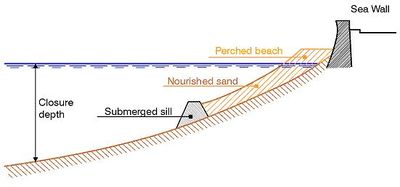Perched beaches
Definition of Perched beach:
Perched beaches are beaches supported at their lower part by a submerged structure. They can be natural or nourished beaches, usually at locations with a steep shoreface.
This is the common definition for Perched beach, other definitions can be discussed in the article
|
Natural perched beaches are a common feature of cliff coasts fronted by a shore platform, see Rocky shore morphology. Such beaches, situated against the cliff base, are protected from erosion by the shore platform. They generally consist of coarse material (sand, pebbles and even boulders) resulting from local cliff erosion.
This article focuses on perched beaches with an artificial sill. The sill generally consists of a rubble mound structure.
Method
A perched beach provides a wider beach at locations where the natural beach has become too narrow and low due to erosion of the coastal profile, see Fig. 1.
The perched beach concept is often used in situations where the coastline has been fixed with a hard structure (seawall, revetment), which has accelerated erosion of the natural beach.
Restoring an equilibrium coastal profile requires sand fill (artificial nourishment) of the subtidal beach down to the closure depth. The required amount of sand depends on the mean grainsize and can be very large if the sand available for beach fill is of the same quality as or slightly finer than the natural sand. A submerged sill to support the lower part of the beach profile considerably reduces the amount of sand needed.
Functional characteristics
The perched beach concept is, in principle, very simple; the submerged sill replaces the outer part of the active equilibrium coastal profile. However, under extreme wave conditions and storm surge, the perched beach profile may adjust to the extreme conditions by moving sand from the upper part of the profile to deeper water, i.e. over the sill. This is often a naturally reversible process for a normal beach profile, but for a perched beach, the process will lead to permanent loss of sand over the sill.
High waves combined with low tide lead to wave-breaking over the sill and hence mass transport of water over the sill. Seaward undertow currents that compensate for this landward transport of water also lead to a loss of sand from the perched beach profile.
If the sill is made very high in order to minimise sand losses, extreme conditions may lead to undesirable wave-breaking and transport of water over the sill. This will produce circulation and undertow currents, both of which are dangerous and difficult to control. In calmer conditions, the high sill may result in stagnant water, poor water quality and obstruction of the sea view.
The conclusion is that a perched beach with an high sill to minimise sand loss has important drawbacks. Maintenance of the sill can require considerable effort and costs.
Applicability
The perched beach concept is applicable on exposed or moderately exposed shorelines with perpendicular or near-perpendicular wave incidence at locations with a steep and eroded coastal profile. It can be a good solution for preserving beaches on urbanized rocky coasts where offshore sand resources are scarce. The perched beach is not an appropriate concept for coasts with oblique wave attack and strong littoral drift. It is also not recommended as a sustainable shoreline management solution on coasts with a sandy shoreface and shelf, due to the risk of dangerous currents and loss of sand over the sill.
Further reading
Mangor, K., Drønen, N. K., Kaergaard, K.H. and Kristensen, N.E. 2017. Shoreline management guidelines. DHI https://www.dhigroup.com/marine-water/ebook-shoreline-management-guidelines
Please note that others may also have edited the contents of this article.
|
